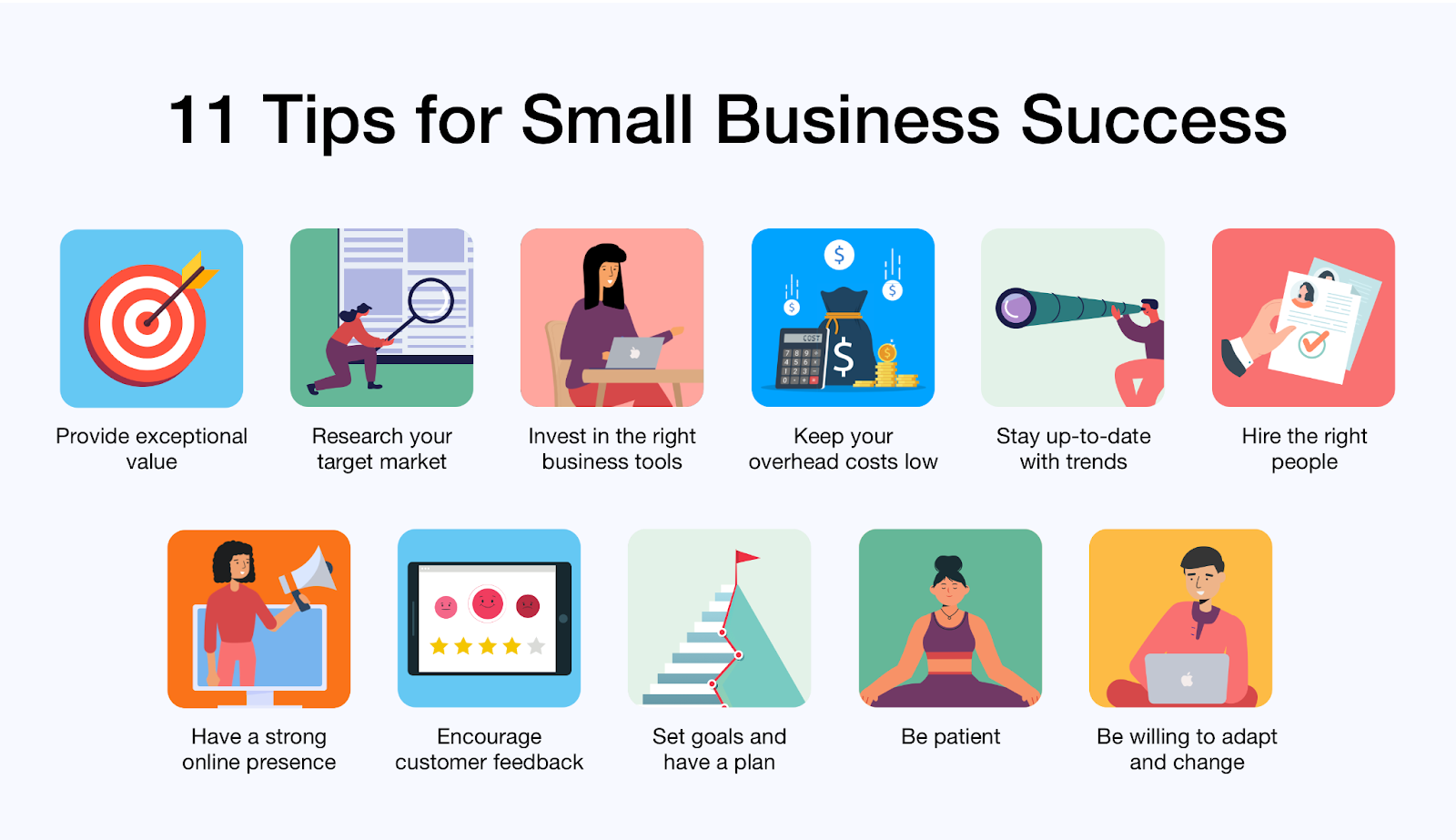Table of Contents
ToggleBuilding a Strong Online Presence: Tips for Small Businesses
In today’s interconnected world, having a solid online presence isn’t just an option—it’s a necessity. Tips for small businesses, this digital footprint can be the difference between thriving and merely surviving. Let’s dive into some practical and impactful strategies to build a robust online presence that will put your business on the map.
1. Create a Professional Website
Your website is your digital storefront. Just as you would ensure your physical shop is inviting, well-organized, and reflective of your brand, your website should offer the same level of professionalism and appeal.
Design and Usability: First impressions matter. A clean, modern design that’s easy to navigate can make a significant difference. Ensure that your site is mobile-responsive because a large percentage of users will access it via their smartphones.
Content is King: Your website should provide comprehensive information about your products or services. Include a blog where you can share industry insights, company news, and helpful tips. This not only positions you as an expert in your field but also helps with SEO.
Contact Details: Make it easy for customers to contact you. Include a contact form, phone number, email address, and physical location if applicable. An interactive map can also be a great addition.
Security: Ensure your website is secure by using HTTPS. This is especially crucial if you’re handling sensitive customer information or transactions.
2. Utilize Social Media Platforms
Social media isn’t just for selfies and cat videos. It’s a powerful tool for businesses to connect with their audience, build brand awareness, and drive traffic to their website.
Choose the Right Platforms: Not all social media platforms are created equal. Identify where your target audience spends their time. For instance, if you’re targeting younger audiences, platforms like Instagram and TikTok might be more effective, whereas LinkedIn is great for B2B companies.
Engage with Your Audience: Social media is a two-way street. It’s not just about broadcasting your message, but also about listening and engaging with your followers. Respond to comments, join conversations, and show your human side.
Content Strategy: Develop a content strategy that includes a mix of posts—promotional content, informative articles, behind-the-scenes glimpses, and user-generated content. Use visuals, videos, and stories to keep your audience engaged.
Consistency is Key: Maintain a regular posting schedule. Inconsistent posting can make your business appear unreliable. Use social media management tools to schedule posts in advance and analyze their performance.
3. Optimize for Search Engines (SEO)
SEO can seem like a daunting task, but it’s crucial for ensuring your business is visible online. When done correctly, it can drive a significant amount of organic traffic to your site.
Keywords: Start by researching relevant keywords for your industry. Use tools like Google Keyword Planner, SEMrush, or Ahrefs to find keywords that your potential customers are searching for. Include these keywords naturally in your website content, blog posts, meta descriptions, and titles.
On-Page SEO: Ensure your website is technically optimized. This includes having a clear site structure, fast loading times, and mobile compatibility. Use header tags to organize your content, and include alt text for images.
Quality Content: High-quality, original content is essential for SEO. Create content that provides value to your audience, answers their questions, and solves their problems. Regularly update your blog with fresh content.
Link Building: Building backlinks from reputable websites can boost your SEO. Reach out to industry influencers, write guest posts, and engage in online communities to generate backlinks.
4. Leverage Content Marketing
Content marketing is all about creating valuable, relevant content to attract and retain your audience. It’s a way to engage your customers and build trust over time.
Blogging: Start a blog on your website where you can share industry news, how-to guides, and insightful articles. Blogging regularly helps with SEO and positions you as an authority in your field.
Video Content: Videos are highly engaging and shareable. Create video tutorials, product demos, or behind-the-scenes looks at your business. Platforms like YouTube and Instagram are perfect for sharing video content.
Infographics: Infographics are a great way to present information in a visually appealing manner. They can simplify complex data and make it more accessible to your audience.
Ebooks and Whitepapers: Offer downloadable resources like ebooks or whitepapers. These can be used to capture leads by requiring users to provide their email addresses to download them.
5. Engage with Your Audience
Building a strong online presence isn’t just about broadcasting your message; it’s about creating a two-way conversation. Engage with your audience to build a community around your brand.
Respond to Comments: Take the time to respond to comments on your blog, social media posts, and other online platforms. This shows that you value your audience’s input and are willing to engage with them.
Ask for Feedback: Encourage your customers to provide feedback. This can be through surveys, reviews, or direct messages. Use this feedback to improve your products, services, and online presence.
Host Online Events: Consider hosting webinars, live Q&A sessions, or virtual workshops. These events can help you connect with your audience on a deeper level and provide valuable information.
Create a Sense of Community: Foster a sense of community by encouraging user-generated content. This could be through contests, hashtags, or by showcasing customer stories.
6. Invest in Online Advertising
While organic reach is essential, investing in online advertising can help you reach a broader audience more quickly.
Google Ads: Google Ads allows you to target specific keywords and demographics, ensuring your ads reach the right people. It’s a pay-per-click platform, meaning you only pay when someone clicks on your ad.
Social Media Ads: Platforms like Facebook, Instagram, and LinkedIn offer robust advertising options. You can target ads based on interests, behaviors, and demographics. Use eye-catching visuals and compelling copy to capture attention.
Retargeting: Retargeting ads can help you re-engage visitors who have previously interacted with your website. These ads can remind them of your products or services and encourage them to return.
Track and Optimize: Always track the performance of your ads. Use analytics to understand what’s working and what’s not. Adjust your strategy based on the data to maximize your return on investment.
7. Utilize Email Marketing
Email marketing is a powerful tool to nurture relationships with your audience. It’s a direct line of communication that can keep your brand top-of-mind.
Build an Email List: Start by collecting email addresses from your website visitors. Offer incentives like discounts, ebooks, or exclusive content in exchange for their email addresses.
Segment Your Audience: Segment your email list based on demographics, purchase history, or behavior. This allows you to send personalized and relevant emails to different groups.
Engaging Content: Create engaging and valuable email content. This could include newsletters, promotional offers, blog updates, or personalized messages. Keep your emails concise and visually appealing.
Automate Campaigns: Use email marketing software to automate your campaigns. Set up welcome emails, abandoned cart reminders, and follow-up emails to streamline your communication.
Analyze Results: Track the performance of your email campaigns. Monitor open rates, click-through rates, and conversion rates. Use this data to improve your future campaigns.
8. Monitor and Analyze Your Online Presence
Regularly monitoring your online presence helps you understand what’s working and where you can improve.
Google Analytics: Use Google Analytics to track your website traffic, user behavior, and conversions. This tool provides valuable insights into how visitors interact with your site.
Social Media Insights: Each social media platform offers its own analytics tools. Use these to track engagement, reach, and follower growth. Analyze which posts perform best and why.
SEO Tools: Tools like SEMrush, Ahrefs, and Moz can help you monitor your SEO performance. Track your keyword rankings, backlinks, and site audits to stay on top of your SEO game.
Customer Feedback: Pay attention to customer feedback on review sites, social media, and your own platforms. This can provide insights into how your audience perceives your brand and what improvements you can make.
9. Collaborate and Network
Networking and collaboration can significantly enhance your online presence. Building relationships with other businesses and influencers can help you reach new audiences.
Partnerships: Collaborate with complementary businesses on joint ventures, co-branded content, or events. This can help you tap into each other’s audiences and create a win-win situation.
Influencer Marketing: Partnering with influencers in your industry can amplify your reach. Choose influencers whose audience aligns with your target market and whose values resonate with your brand.
Guest Blogging: Write guest posts for reputable blogs in your industry. This can help you gain exposure, build backlinks, and establish yourself as an authority.
Online Communities: Join and participate in online communities, forums, and groups related to your industry. Share your expertise, engage in discussions, and build relationships.
10. Stay Updated with Trends
The digital landscape is constantly evolving. Staying updated with the latest trends and technologies is crucial for maintaining a strong online presence.
Industry Blogs: Follow industry blogs and news sites to stay informed about the latest trends, tools, and best practices. Websites like HubSpot, Moz, and TechCrunch are great resources.
Webinars and Conferences: Attend webinars, online courses, and conferences to learn from industry experts. These events can provide valuable insights and networking opportunities.
Continuous Learning: Invest in your own learning and development. Take online courses, read books, and participate in online forums to keep your knowledge up-to-date.
Adapt and Innovate: Be willing to adapt and innovate your strategies. What worked yesterday might not work tomorrow. Stay agile and open to new ideas to stay ahead of the competition.


